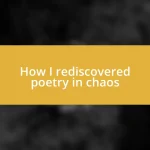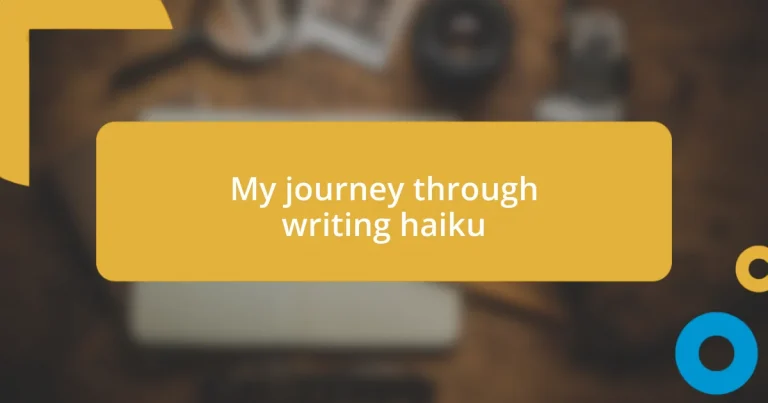Key takeaways:
- Haiku became a means of self-expression, allowing the author to distill complex emotions into a structured form that resonates with the beauty of nature.
- The editing process is crucial, as careful selection of evocative language and refinement of rhythm enhances the haiku’s impact and clarity.
- Sharing haiku, both online and in person, fosters connections with others, highlighting poetry’s power to evoke emotions and create shared experiences.
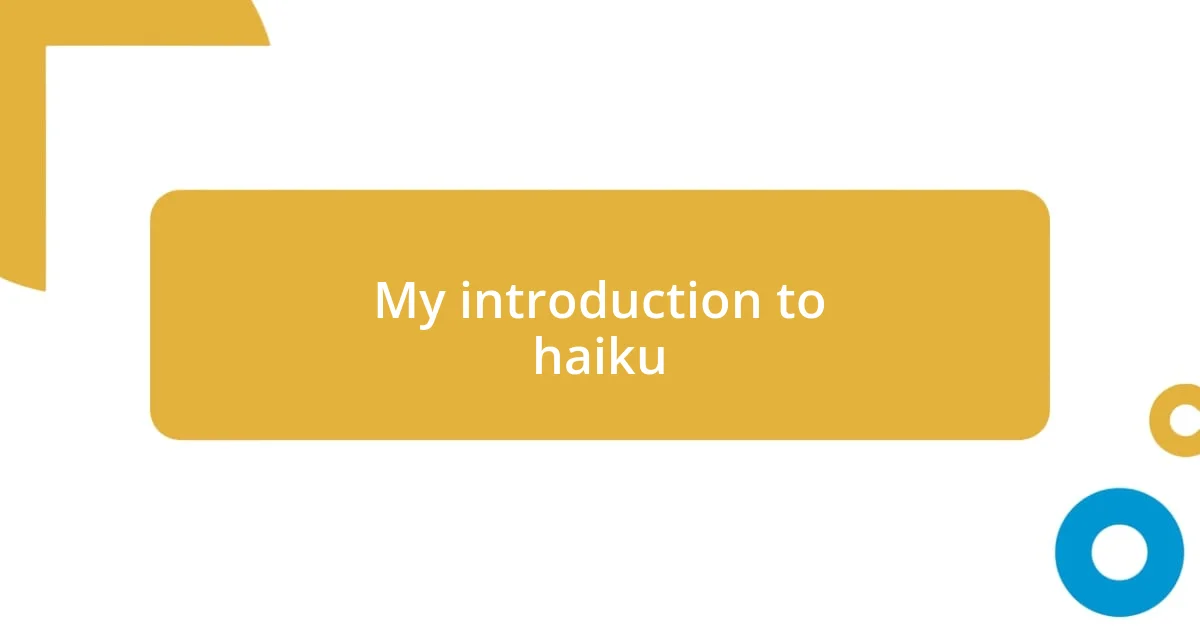
My introduction to haiku
I discovered haiku during a creative writing class in college, sitting in a quaint little room. The instructor, with a spark in his eye, introduced us to this ancient form of poetry. At first, I felt a bit intimidated by the discipline of sticking to a 5-7-5 syllable structure, but there was something intriguing about the simplicity that promised depth.
One memorable assignment had us venturing outside to find nature’s inspiration. I remember standing beneath a cherry blossom tree, the delicate petals drifting down like soft whispers. In that moment, I learned that haiku could capture fleeting beauty and evoke profound emotions. Have you ever stumbled upon a scene so striking that it felt like time stopped? That’s exactly what happened to me, and it gave me a taste of how powerful and evocative haiku can truly be.
As I continued my journey with haiku, I realized it wasn’t just about the format but about distilling experiences into their essence. Each poem became a little window into my thoughts and feelings. In those structured lines, I found freedom—a way to express complex emotions with just a few words. Is there anything more exhilarating than finding your voice in a form as stark yet poignant as this? It felt like I was not just writing but connecting with the heartbeat of the world around me.
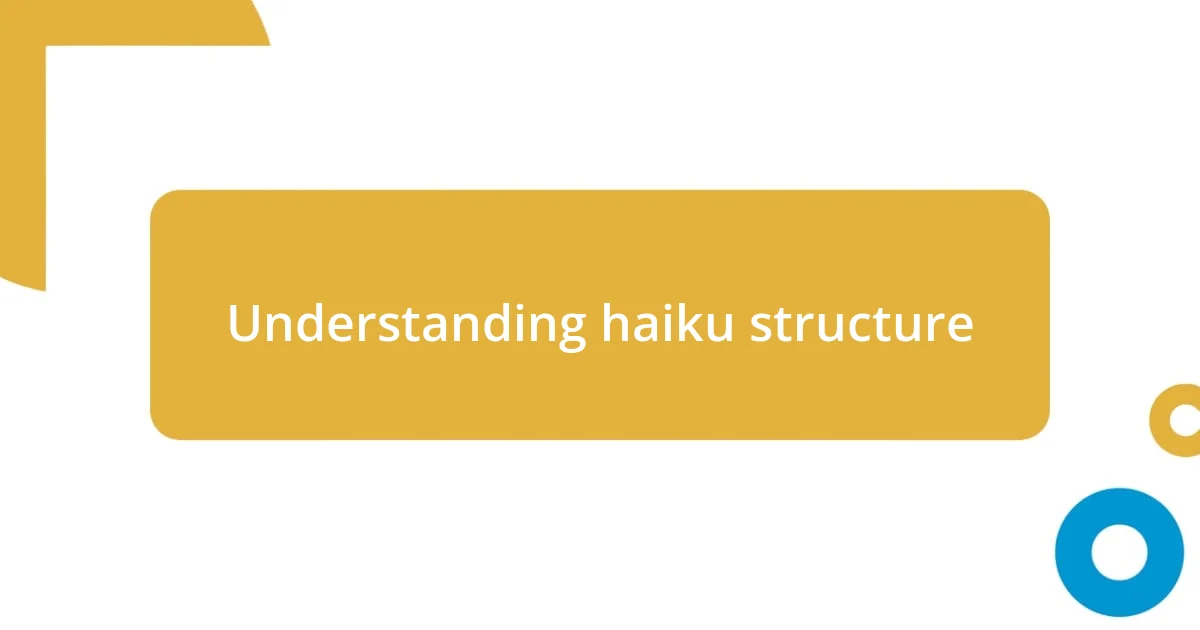
Understanding haiku structure
The haiku structure is beautifully straightforward, consisting of just three lines with a syllabic pattern of 5-7-5. This means the first line has five syllables, the second seven, and the third five again. I remember when I first experimented with this form; it was like solving a delightful puzzle. Fitting my thoughts into these constraints challenged me, but I found joy in discovering the precise words that conveyed deep meanings.
One aspect that I particularly love about haiku is its focus on nature and seasonal themes, known as “kigo.” This element adds context and layers to the poems, evoking imagery that resonates with readers. I recall writing a haiku about the first snowfall of winter, where capturing the moment in just a few words felt almost magical. The hushed tranquility of snow blanketing the world around me transformed into an emotional snapshot, allowing me to share that instant with others.
Additionally, haiku often includes a “kireji” or cutting word, which provides a pause and creates a sense of juxtaposition or contrast within the poem. This technique enriches the reader’s experience, encouraging reflection. I remember incorporating a pause in one of my haikus that shifted the mood unexpectedly, drawing out a new interpretation from my readers. Such techniques demonstrate that even a few carefully chosen words can open up vast worlds of meaning.
| Aspect | Description |
|---|---|
| Syllable Structure | 5-7-5 pattern |
| Focus | Nature and seasons (kigo) |
| Juxtaposition | Use of cutting word (kireji) |
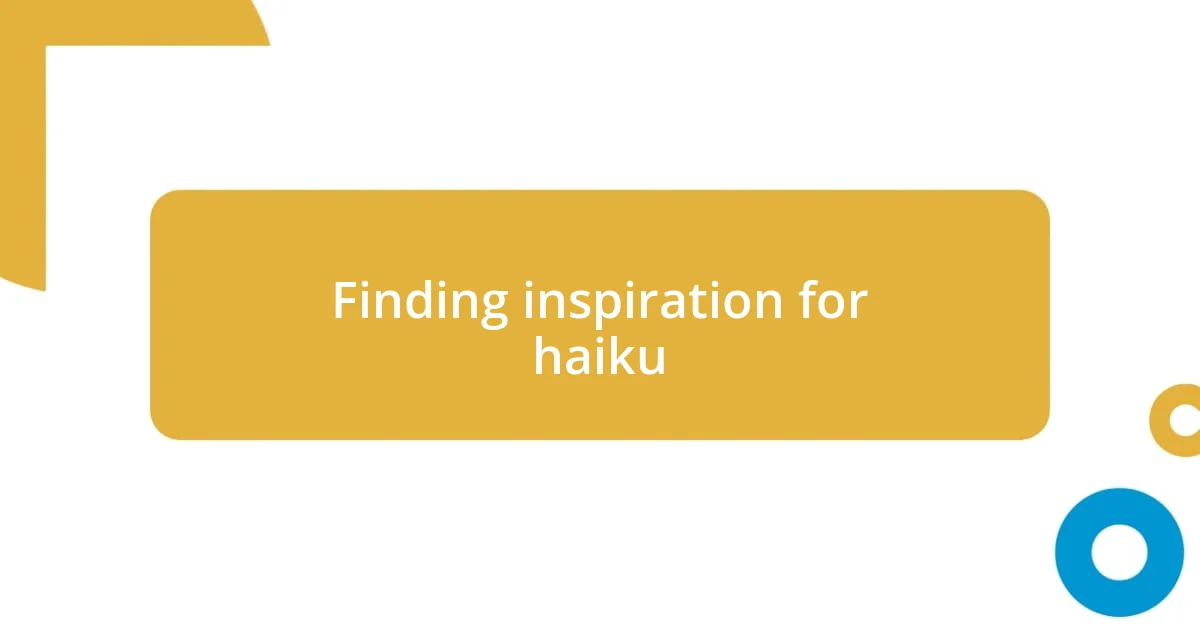
Finding inspiration for haiku
Finding inspiration for haiku often strikes when I least expect it. Sometimes, it occurs during everyday moments—like sipping tea on a rainy afternoon or walking through a crowded market. I recall one instance when I was simply listening to the rustling leaves in my backyard; it felt like nature was whispering a secret, and I eagerly scribbled down a few lines capturing that fleeting connection.
To help tap into this wellspring of inspiration, I often rely on a few techniques:
- Mindfulness: Paying attention to my surroundings encourages me to notice details I might otherwise overlook.
- Prompt Journals: Using prompts or themes allows my creative juices to flow, offering starting points for my haikus.
- Nature Walks: Stepping outside often leads to spontaneous observations that spark ideas for new poems.
By engaging deeply with the world around me, I find haiku becomes a reflection of my experiences, allowing a moment to resonate far beyond its simplicity. There’s something incredibly fulfilling about distilling these moments into three lines, creating poetry that feels like a shared heartbeat with others.
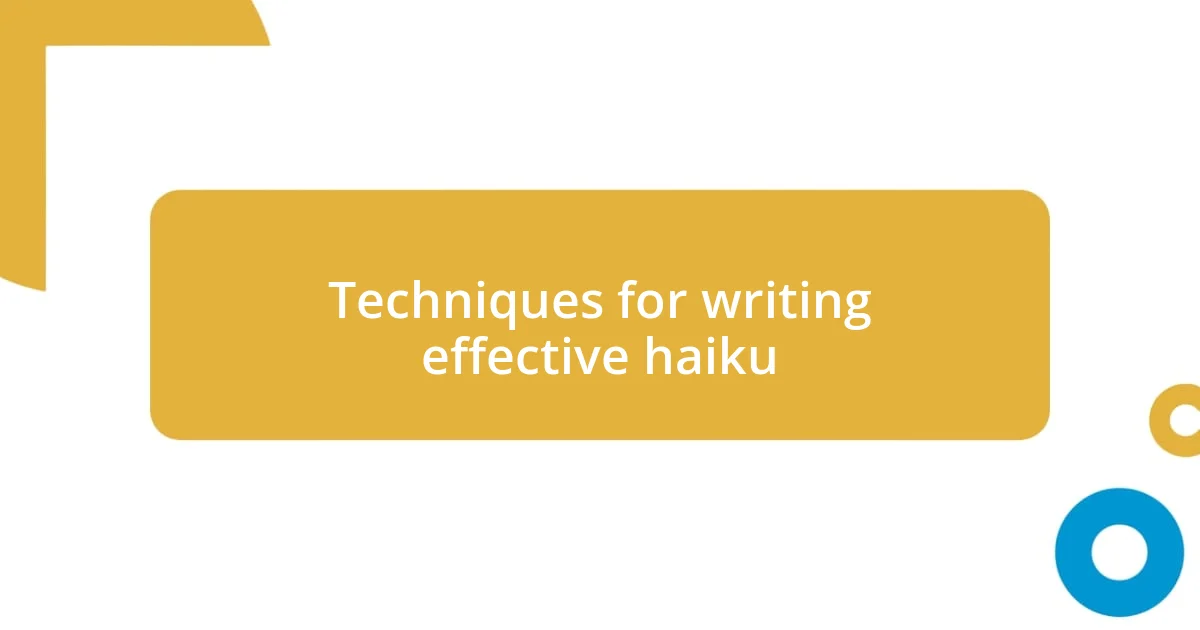
Techniques for writing effective haiku
One effective technique I’ve embraced is the art of observation. I remember sitting on my porch early one morning, coffee in hand, watching the world wake up. The way the sunlight glinted off dewdrops on the grass struck me as poetic, prompting me to jot down lines that captured that serene moment. When crafting haiku, immersing yourself in your surroundings can unlock profound inspiration. Have you ever noticed how a simple scene can unfold into a world of emotions through just a few words?
Another technique I find invaluable is playing with sensory details. Engaging multiple senses can add depth to a haiku, inviting readers into your experience. For instance, while watching a sunset, I not only focused on the vibrant colors but also on the chill in the evening air and the sound of distant waves. It’s fascinating how these sensory elements weave together to create a richer tapestry of imagery. In my writing, I often ask myself: what do I see, hear, and feel? This reflection brings a more vivid essence to my haikus.
Lastly, revising is key in honing a haiku’s impact. I’ve learned that the first draft is seldom the final version. Once, after writing a haiku about a spring storm, I realized it lacked punch. I let it sit for a day, returning with fresh eyes to refine the language and structure. That extra layer of revision allowed me to capture the tension of the storm perfectly. It’s a reminder that crafting haiku is a journey; each word must resonate, and sometimes it takes a little time to find the right one.
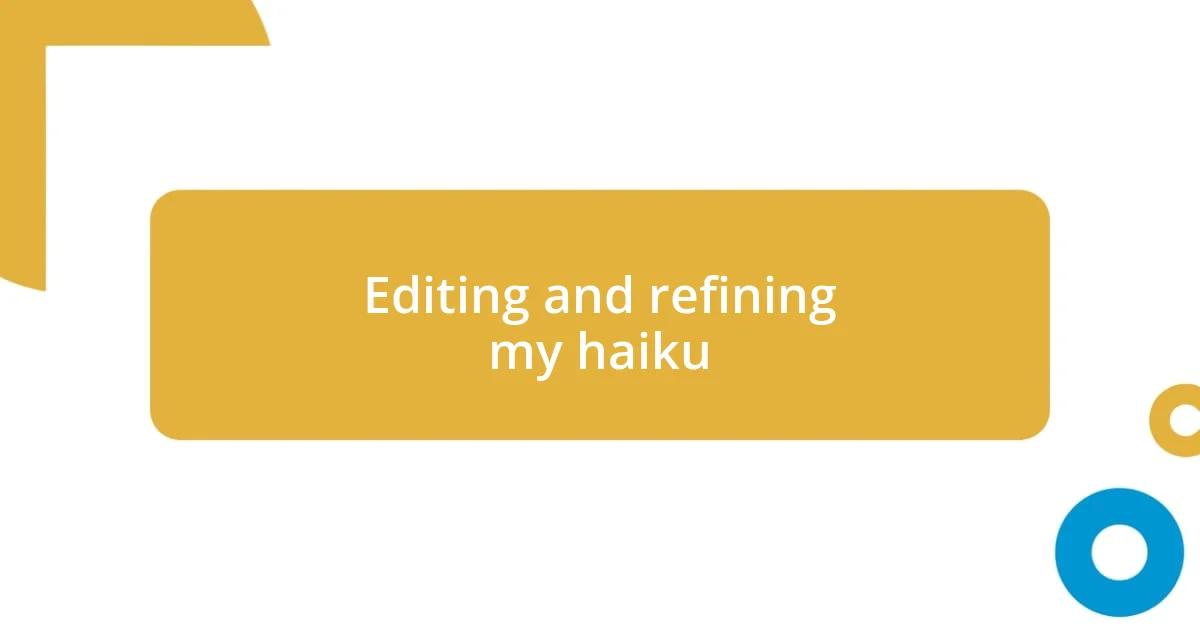
Editing and refining my haiku
Editing haiku is where the magic truly happens for me. After putting my initial thoughts on paper, I often find myself reworking the language to enhance the imagery. I recall a time when I wrote a haiku about a winter morning. The first version felt lackluster. It wasn’t until I searched for more evocative words, like “whispering frost” instead of just “cold,” that the piece began to shimmer. Isn’t it amazing how one word can shift the entire mood?
As I dive into the editing process, I make sure to read the haiku aloud. This practice helps me catch any awkward phrasings and evaluate the rhythm. Like a musician fine-tuning their melody, I often adjust syllable count until it flows effortlessly. A memorable moment for me was when I struggled with the line about falling leaves. After several iterations and a few deep breaths, I settled on “golden whispers dancing down”—its cadence felt just right. Have you ever experienced the satisfaction of discovering that perfect rhythm?
Ultimately, I’ve discovered that editing is as much about cutting as it is about refining. Sometimes, less truly is more. I remember a haiku I wrote that had an additional line I thought was clever, but it cluttered the essence of the poem. Once I trimmed that excess, the remaining words resonated with clarity. In my experience, the editing phase is not just an obligation but a delightful opportunity to reimagine my work, letting the core message shine through the simplicity of each syllable.
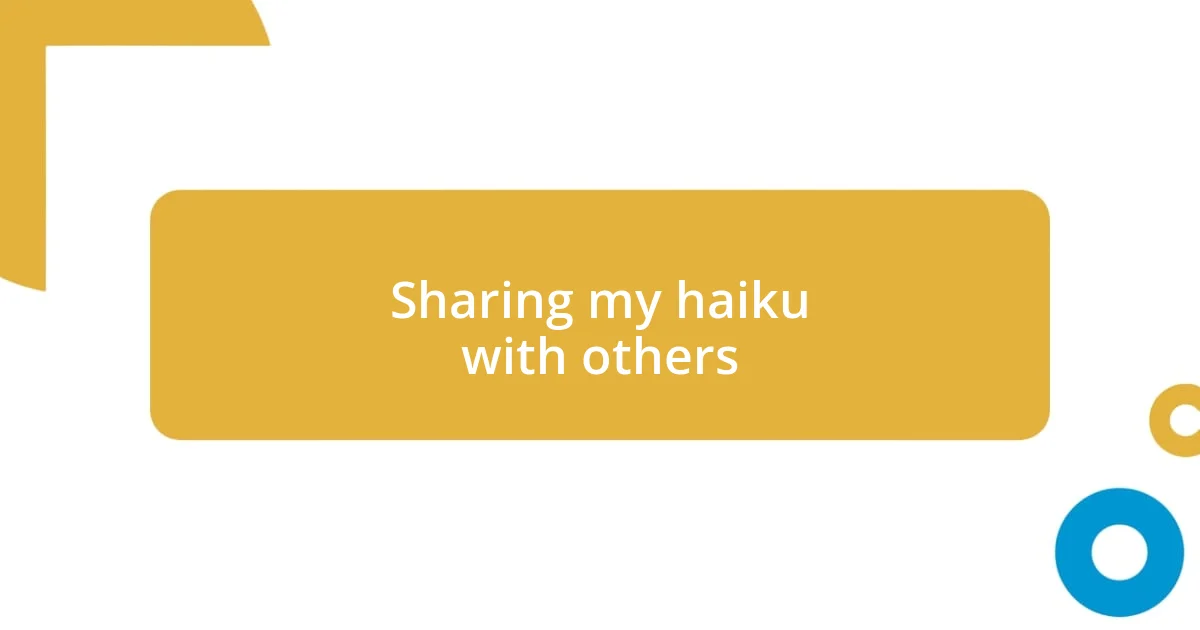
Sharing my haiku with others
Sharing my haiku is always an exhilarating experience. I remember the first time I read my work aloud to a small group of friends; their smiles and nodding heads filled me with joy. In that moment, I realized that haiku is not just a solitary endeavor; it transforms when shared, inviting others into my world.
I often post my haiku on social media, where I connect with a wider audience. The instant feedback and encouragement from fellow writers can be incredibly motivating. One day, I shared a haiku about the sound of rain gently tapping on my window. Someone commented, saying it reminded them of a cherished childhood memory. This exchange left me pondering: Isn’t it wonderful how a few simple lines can evoke such powerful feelings in others?
Beyond just sharing online, I’ve started participating in local poetry readings. Standing up and reciting my haiku in front of an audience is nerve-wracking, but each time I do it, I feel more confident. It becomes a shared experience, creating a space where emotions resonate and connections deepen. I often reflect on how poetry has the unique ability to bring strangers together, igniting conversations that linger long after the last line is spoken.
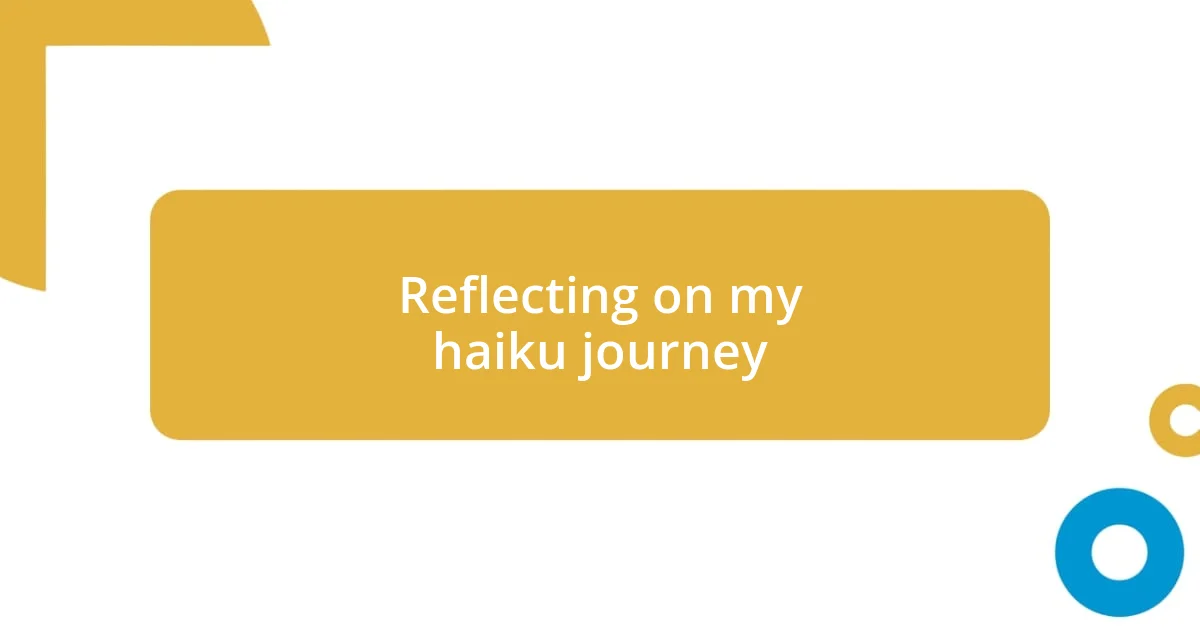
Reflecting on my haiku journey
Reflecting on my haiku journey has been a profound experience, filled with lessons and unexpected discoveries. I’ll never forget the moment I came across a haiku that sparked something deep within me. It made me realize the power of brevity—how just a few words can encapsulate a moment or feeling. Have you ever felt that electricity when a piece of art resonates so strongly that it changes the way you see the world?
Throughout my journey, I’ve witnessed my thoughts evolving through the lens of haiku. Early on, my haikus often mirrored my own experiences, but as I engaged more with the form, I began to incorporate nature and the seasons. I vividly recall watching cherry blossoms sway in the breeze and feeling compelled to capture that fleeting beauty. That moment taught me that writing haiku is not just about what I want to express but also about observing the world around me.
There’s a certain humbling realization that comes with looking back at my earlier works. I often shake my head at my first attempts, wondering how I thought they were good enough to share. However, I’ve learned that this growth is part of the process. Isn’t it comforting to know that evolution is a natural part of any creative journey? Each haiku, from the ones I’m proud of to those I wish to forget, tells a story of my development as a writer and person.







